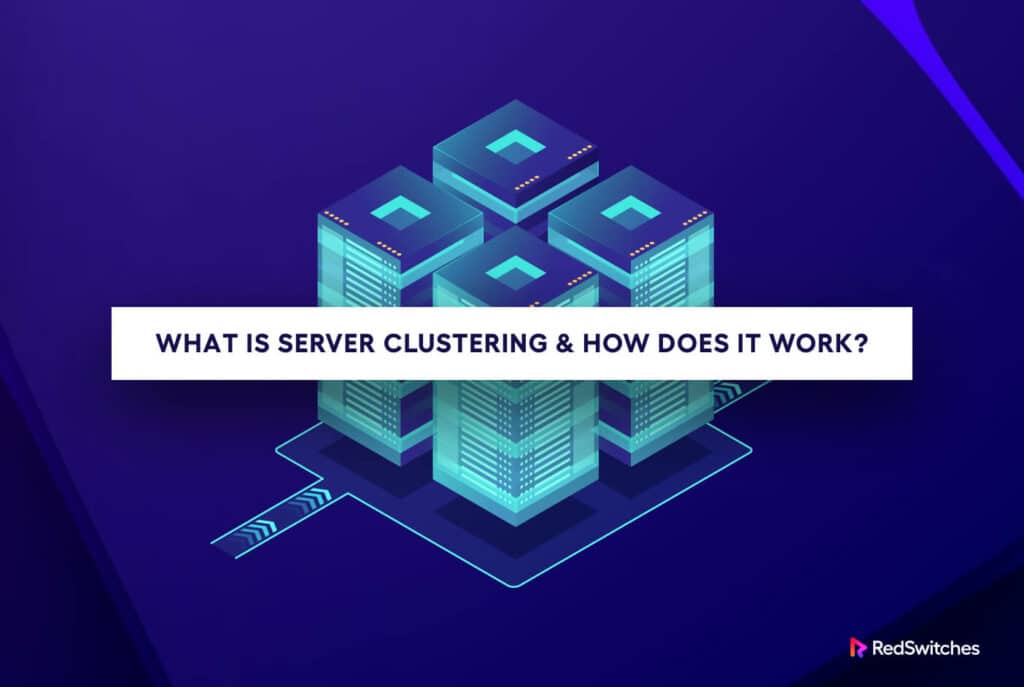Server uptime is an essential requirement for any business that offers online services.
That’s because downtime can wreak havoc on your business, resulting in disappointed clients, revenue loss, and a damaged reputation.
That’s why, regardless of their industry, businesses should consider investing in high-performance server clusters to improve the uptime of the hosted web services.
This article will introduce the idea of server clustering, the benefits of server clusters, and a brief overview of the various practical implementations of the idea.
Table Of Contents
- What is a Server Cluster??
- Basic Components of High Availability Clusters
- How Do Server Clustering Work??
- 3 Main Benefits of Using Server Clustering
- 3 Types of Server Clustering
- Get High-Quality Dedicated Servers With RedSwitches
- FAQ – Server Clustering
- Conclusion
Key Takeaways
- A server clustering is a group of servers working simultaneously as a single hosting solution under the same IP address and hostname.
- They provide increased availability, failover protection, and scalability.
- There are three types of server clusters:
- Single quorum cluster
- Majority node set cluster
- Single node cluster
What is a Server Cluster?
Server clustering is a group of servers that work together as a single hosting solution that has a single IP address and hostname. The servers in a server cluster are called nodes.
By grouping multiple servers, server clusters minimize downtime and service outages by distributing the workload across the nodes. This arrangement is also known as a high availability cluster because it ensures significantly higher uptime and sustained performance, regardless of the volume of user requests.
Server clusters support your business growth by delivering scalability for your hosted services.
Depending on the server type, scaling can be either automatic (using cloud servers) or manual (using other types of servers).
Looking for cheap and high-quality dedicated servers? Take a look at our offers!
Basic Components of High Availability Clusters
The performance of a high-availability cluster depends upon the components you introduce to the cluster mix. In general, a server cluster is made up of the following components.
Nodes
Nodes are the individual servers that form the core of an HA cluster. They can be physical or virtual machines that run the required services and applications. These nodes work together to provide redundancy and load balancing in the event of a failure of one or more nodes. In addition to running the services, nodes communicate with each other over a dedicated network connection to synchronize data and share resources.
Connectivity
A high-speed and reliable network is crucial for the performance of an HA cluster. The network serves as the backbone of the cluster and ensures that nodes can communicate with each other and share resources. This network is typically isolated from other networks to prevent interference and ensure the highest possible level of performance.
Load Balancers
Load balancers are used to distribute traffic between the nodes in the cluster. Load balancers distribute incoming requests evenly across multiple nodes, preventing one node from becoming overloaded with requests. In addition, load balancers can detect when a node fails and automatically redirect traffic to other available nodes.
Cluster Managers
Cluster managers are responsible for monitoring the health of the nodes in the cluster and managing the failover process in case of a failure. Cluster managers use various techniques to monitor the nodes, including heartbeats, health checks, and other indicators.
In the event of a failure, the cluster manager automatically migrates services and applications to a healthy node to ensure that users can continue to access them without interruption.
Get a Pre-Optimized Dedicated Server
Blazing Fast Speed and Fully Managed Server Like Never Before
Storage
Shared storage is essential for an HA cluster because it allows all nodes to access the same data. Generally, network admins opt for technologies such as a storage area network (SAN), network-attached storage (NAS), or other storage technologies to set up shared storage. The shared storage allows the cluster to maintain consistency across all nodes, even in the event of a node failure.
In addition to these factors, high availability, backup, and recovery are critical for the operations of HA clusters. An effective backup and recovery strategy should include regular backups and the ability to restore data quickly for faster recovery from disasters. This strategy should be tested regularly to ensure that it is effective and can be executed quickly.
How Do Server Clustering Work?
Depending upon the implementation, server clusters operate on a similar pattern.
Each dedicated server within a server cluster is a node with its own set of resources, such as storage, RAM, and CPU. As such, each server node is part of the cluster, while at the same time, maintaining a copy of the server cluster’s operating system, services, and applications.
Generally, at any given time, only one node within a server cluster is operational, while others are in the stand-by mode. If an active node fails to serve a request, the server cluster redistributes the workload amongst other nodes. Thanks to this feature, users experience no downtime while using your website or app, regardless of the load on the server.
The immediate switchover between server nodes is made possible by a quorum, a shared storage system used by all nodes in a server cluster. Typically, the quorum holds information on the server cluster infrastructure and tracks new changes.
In short, all nodes within a server cluster are programmed to collaborate. As such, server clusters help the business avoid downtime by balancing the workload amongst several nodes.
3 Main Benefits of Using Server Clustering Server Clustering
The three main benefits of server clusters include increased availability, failover protection, and scalability.
Let’s take a detailed look at each of them:
1. Increased Availability
High-availability server clusters offer increased availability for your hosted services by sending user requests to different nodes if one node is already busy.
So, for example, if you’re hosting a web app on a single server and it’s busy serving some users, other users might have to wait until the server is free to respond to their request.
In contrast, a server cluster has multiple nodes that can take up the slack. So, if one node is busy, another node is able to serve the request. As such, high-availability server clusters allow more people to use your website or web app at the same time.
2. Failover Protection
Failover protection is crucial as it maximizes infrastructure and application reliability. As such, it prevents data loss and service outages due to hardware malfunctions, software failure, or other issues like natural disasters.
Simply put, failover ensures that your services don’t shut down in case one of the nodes fails. In this scenario, another node immediately takes over the operations without the user knowing about the failure. This feature is crucial as downtime can result in unsatisfied clients or revenue loss.
With clustered servers, your data is protected against three main types of outages, including:
Application (Service) Failures
Application/service failures are events in which critical errors occur in software or services that’s critical to the business operations. These issues can be caused by numerous factors, many of which are hard to predict and mitigate. Because of this, server admins are often unable to predict and pinpoint these potential issues.
A proactive and skilled server administrator can identify and address such an issue before they become a problem.
Hardware (System) Failures
This type of outage occurs because of physical hardware failures of the server. These outages can affect every server component that’s crucial to the functionality of a server.
Hardware failures can occur for numerous reasons, but they’re mostly a result of poor optimization, overheating, or a component reaching the end of its lifespan.
Even though no hardware component is immune to failure, here are the ones most prone to issues:
-
-
- CPUs
- Hard drives
- Power supplies
- Physical memory
-
Site Failures
Most of the time, site failures are events that occur at the data center location, such as natural disasters that can cause widespread power outages (e.g., floods, fires, etc.).
Even though natural disasters cannot be avoided by anything other than careful selection of the site location. That’s why server clusters are crucial for data centers and servers located in areas prone to natural disasters.
3. Scalability
Whether you’re hosting a web application or a website, you might eventually outgrow your hosting solution and need more processing power.
At this point, you have two options:
-
-
- Upgrade your dedicated server
- Using a server cluster
-
Server clustering give you tons of room to grow by allowing you to easily scale your hosted web services. As such, using a server cluster enables you to have more content to your website, upgrade your web application with more services, and more.
3 Types of Server Clustering Server Clustering
Based on how nodes are connected to the device that stores configuration data, server clusters fall into one of three types:
1. Single Quorum Cluster
Also called the standard quorum cluster, a single quorum cluster is the most popular server cluster type.
This type of server clustering has several nodes with one or multiple cluster storage arrays that utilize a single connection device, such as a bus.
All cluster disk arrays are managed and owned by a single server within the server cluster, and each node notifies the central bus that it’s online and uncompromised.
The system that determines if each cluster is online and functional is called the titular quorum.
As long as more than 50% of the nodes in a single quorum cluster are functional and online, the cluster keeps operating. If not, the server cluster stops working until individual nodes are fixed.
2. Majority Node Set Cluster
Majority node set clusters are most often used for server clusters that have server nodes located in different geographic locations.
That’s because each node owns and manages its copy of the cluster’s configuration data in this server cluster type. With the help of quorum resources, this data stays consistent across all nodes.
Unlike in single quorum clusters, in majority node set clusters, each node stores a copy of the quorum locally, so this server cluster type doesn’t need a shared storage bus to be functional, allowing more flexibility for remote server configuration.
3. Single Node Cluster
Single node clusters contain a single node and are typically used for testing, developing, and researching cluster applications.
Single node clusters are rarely used outside of these circumstances. They are heavily limited due to the lack of failover protection, since the failure of one node disrupts the whole cluster.
Get High-Quality Dedicated Servers With RedSwitches
If you need premium dedicated hosting, look no further because RedSwitches has the exact solution you need!
We offer high-quality dedicated servers that include:
-
-
- 24/7/365 support
- Unmetered bandwidth options
- Free 5Gbps DDoS protection
- Free setup with all servers
- Intuitive control panel
- Unlimited upgrade choices
- On-demand IPMI/KVM access
- And more!
-
Send us a message today or schedule a free consultation, and our team of IT experts will be there to create a customized dedicated hosting solution for your business.
FAQ – Server Clustering
1. What is meant by Server Clustering server clustering?
A cluster is a group of servers working together as a single system that enables high server availability, load balancing, and parallel processing.
2. What is a node?
A node is an individual server in a server cluster. It operates as part of the server cluster. Nodes can either be physical or virtual instances of a server.
3. How many servers are in a cluster?
A cluster can consist of at least two servers, also known as a two-node cluster. However, you can add as many servers as you need in a cluster.
4. What is the purpose of failover clustering?
Failover clustering exists to maintain the high availability of web applications and services. Failover clustering is used in case one of the hosting servers, or nodes, fails, as another node in the cluster can take its workload without causing downtime.
Conclusion
Server clustering is an idea for delivering software services to all users. Businesses need maximum uptime to ensure the quality of user experience. Setting up server clustering involves a careful study of the business operations so that the server cluster can cater to the current and foreseeable future requirements.
Let us know if you have a server cluster for servicing your business operations.



